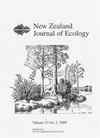Population trends of house mice during tussock mast seeding on Auckland Island
IF 1.4
3区 环境科学与生态学
Q3 ECOLOGY
引用次数: 7
Abstract
: House mice ( Mus musculus ) are an invasive species on Auckland Island in the New Zealand subantarctic and planning for their eradication is underway. Mast seeding events cause rodent populations to irrupt, though little is known about this phenomenon in snow tussock grass ( Chionochloa spp.) systems on Southern Ocean islands. The aim of this study was to understand population fluctuations of mouse abundance on Auckland Island for the 2 years following a mast event, and with which tools to monitor abundance, to inform planning of bait application for eradication. Mouse populations were studied using kill and live trapping at two sites on Auckland Island, and mouse density was estimated using spatially explicit capture-recapture models. Mouse population density was highest during summer mast seeding of Chionochloa antarctica and then declined the following winter and subsequently remained low for the following year. Breeding remained seasonal, with a pulse in early summer and a very low level continuing through winter in both years, regardless of mast conditions. These results are similar to those from other cool temperate Southern Ocean islands where seasonal resource availability appears to drive breeding. Throughout the study the capture probability of mice was generally higher when population density was lower, which highlights that conclusions about population trends could be misleading if abundance indices are not calibrated to measures of population density. Mouse eradication should preferentially take place outside of a mast event but would likely still succeed during and following a mast event. Our work fills a key knowledge gap about rodent population trends during mast events for Southern Ocean islands, which is particularly important where eradications are planned.奥克兰岛柞蚕桅杆播种期间家鼠种群动态
:家鼠(Mus musculus)是新西兰亚南极奥克兰岛上的一种入侵物种,根除计划正在进行中。桅杆播种事件会导致啮齿动物数量激增,尽管人们对南大洋岛屿上雪草丛(Chionochloa spp.)系统中的这种现象知之甚少。本研究的目的是了解桅杆事件发生后2年奥克兰岛老鼠数量的波动,以及监测数量的工具,为根除诱饵应用的规划提供信息。在奥克兰岛的两个地点,使用捕杀和活体诱捕对老鼠种群进行了研究,并使用空间显式捕获-再捕获模型估计了老鼠密度。小鼠种群密度在南极Chionochloa夏季桅杆播种期间最高,然后在第二个冬天下降,随后在第二年保持较低水平。繁殖仍然是季节性的,无论桅杆条件如何,初夏都有脉动,而这两年的繁殖水平都很低,一直持续到冬季。这些结果与南大洋其他冷温带岛屿的结果相似,这些岛屿的季节性资源可用性似乎推动了繁殖。在整个研究过程中,当种群密度较低时,老鼠被捕获的概率通常较高,这突出表明,如果丰度指数不与种群密度的测量值相校准,关于种群趋势的结论可能会产生误导。小鼠根除应优先在肥大事件之外进行,但在肥大事件期间和之后仍有可能成功。我们的工作填补了关于南大洋岛屿桅杆事件期间啮齿动物种群趋势的关键知识空白,这在计划根除的地方尤为重要。
本文章由计算机程序翻译,如有差异,请以英文原文为准。
求助全文
约1分钟内获得全文
求助全文
来源期刊

New Zealand Journal of Ecology
环境科学-生态学
CiteScore
3.00
自引率
12.50%
发文量
35
审稿时长
>36 weeks
期刊介绍:
The New Zealand Journal of Ecology is a biannual peer-reviewed journal publishing ecological research relevant to New Zealand/Aotearoa and the South Pacific. It has been published since 1952 (as a 1952 issue of New Zealand Science Review and as the Proceedings of the New Zealand Ecological Society until 1977). The Journal is published by the New Zealand Ecological Society (Inc.), and is covered by Current Contents/Agriculture, Biology and Environmental Science, GEOBASE, and Geo Abstracts.
 求助内容:
求助内容: 应助结果提醒方式:
应助结果提醒方式:


